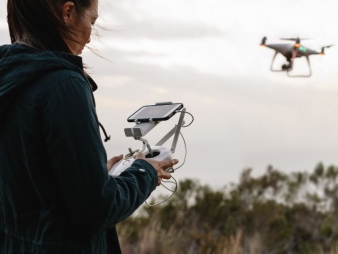If you go to the beach, you may see the lifeguard sending a life preserver to a distressed swimmer by drone from their observation chair. The delivery is quicker, does not endanger other lives, and is precise. Cell towers are being inspected by drone, crops are being managed by drones, and what home can be sold today without a drone video?
The law concerning drones changes almost daily and is often subject to inappropriate and incorrect interpretation by the so called “internet experts.”
There are three basic types of drone operations: The hobbyist; the Public Entity Use Certificate of Authorization; and the certified drone operator under 14 CFR Part 107.
All drones require registration unless the drone weighs less than .55 pounds. Otherwise all drones between .55 pounds and less than 55 pounds now require registration. (Section 1092 of the National Defense Authorization Act for FY 2018 – Pub. L. No. 115-91 restored the FAA registration requirement that had been struck in the case of Taylor v. Huerta, 856 F. 3d (D.C. Cir 2017.) At present, the hobbyist registration appears to be a one-time registration.
A Commercial Use drone requires registration and renewal every three years. Registration can be accomplished via the FAA portal if less than 55 pounds.
Use of drones for commercial purposes not properly registered can result in civil and criminal penalties by the FAA. A recreationally registered drone cannot be used for commercial purposes.
No medical is required to operate a drone; however, at least for commercial operators, 14 C.F.R. Section 107.7 provides that no person may manipulate the flight controls of a small unmanned aircraft system (sUAS) or act as a remote pilot in command, visual observer, or direct participant in the operation of a small unmanned aircraft if he or she has a physical or mental condition that would interfere with the safe operation of the small unmanned aircraft system.
At present, there is a conflict between the FAA, state, and local authorities on regulating where hobbyist may fly a drone and what entity has authority over the drone pilot.
It is clear that no person, a hobbyist, commercial operator, or an individual operating under a Public Use Entity Certificate, may violate a temporary flight restriction (TFR.) TFRs are restricted airspace created to protect certain government and international officials. They also apply to certain stadiums where crowds could exceed 30,000. This would include a professional or large college stadium during an event.
If a hobbyist pilot operated a drone while intoxicated or in a threatening manner, while the FAA may not prosecute the pilot, local and state laws would apply and the pilot could be prosecuted accordingly. A commercial pilot could be subject to prosecution by the FAA as well as local authorities.
A clear dividing line on operations has now been developed. If the operator is using the drone for law enforcement or public use, a certificate through the FAA must be requested. The entity may also secure the services of a Part 107 licensed (sUAS) pilot.
The Part 107 sUAS pilot must hold a FAA certificate. For non-pilots, to obtain a sUAS certificate, schooling and a test is required. The schooling is similar to ground school for pilots.
Private or commercial pilots may obtain a Part 107 license by taking an FAA examination, and having completed a biennial flight review within two (2) years. A certified flight instructor (CFI) must also certify the pilot has completed the biennial flight review requirement to the FAA as part of the application.
A hobbyist pilot of a drone operates pursuant to industry recommendations and not Part 107 regulations. The pilot may not violate a TFR or local rules.
Part 107 sUAS pilots are subject to more restrictive operations. These include: operation within line of sight (no binoculars, but you may use an observer); you must fly during daylight or in twilight (30 minutes before sunrise or after sunset); the maximum allowable altitude is 400 feet; less than 100 mph; and you may not fly over anyone not directly participating in the operation, under a covered structure, inside a covered stationary vehicle, or from a moving vehicle unless in a sparsely populated area.
Operation in class G airspace is allowed without air traffic control permission. Operations in class B, C, D, and E airspace requires approval which can be obtained using websites approved by the FAA. These websites are also recommended for use by the hobbyist as they provide information on TFRs.
sUAS pilots may transport property with the drone, with some exceptions, if flight qualities are not affected.
All drone pilots must make the drone and the accompanying records available to the FAA for inspection. If you are involved in an operation that results in serious injury, loss of consciousness, or property damage other than to the UAS of at least $500.00, the incident must be reported to the FAA.
Can a licensed real estate agent use a drone to photograph a home to be advertised for sale as a hobbyist? The answer is no. This use would be for a for-profit operation and requires the drone to be registered and the operator to be properly licensed. Photography where a profit is derived is a commercial drone operation and must be operated pursuant to Part 107. Using a drone for commercial use while not properly licensed or operating a drone in a reckless manner is typically an easy prosecution for the FAA as there is almost always photographic evidence.
While Part 107 may seem very restrictive to licensed operators, except for operations outside the line of sight, the FAA will, upon request, grant waivers upon proof of safe operation. This includes night flight and the operation of multiple drones by one controller via computer.
Drones will become larger and more useful in the coming years. Be cautious to keep current with the law. The criminal and civil fines are quite significant and the defense is costly.
Kim M. Rose is an AOPA panel attorney. He is a commercial pilot and holds a Part 107 sUAS certification.




